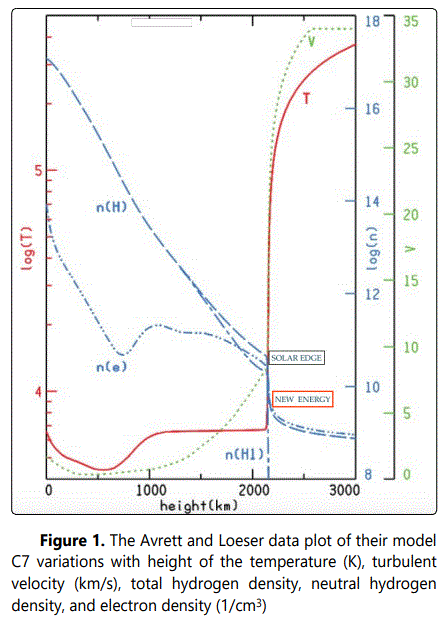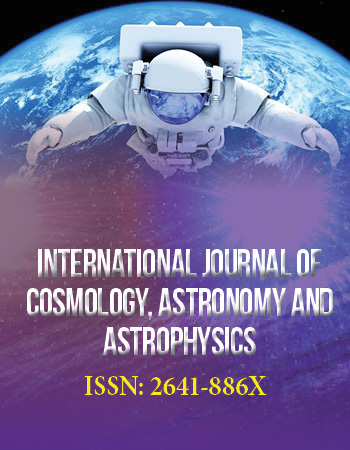Letter to Editor
How the Tresino Phase-Transition Heats the Solar Corona and Energizes the Solar Wind
Mayer Applied Research Inc., USA
*Corresponding author: Frederick J. Mayer, Mayer Applied Research Inc. 1417 Dicken Drive, Ann Arbor, MI 48103, USA, E-mail: fred@frederickjmayer.net
Received: July 05, 2023 Accepted: July 12, 2023 Published: July 19, 2023
Citation: Mayer FJ. How the Tresino PhaseTransition Heats the Solar Corona and Energizes the Solar Wind. Int J Cosmol Astron Astrophys. 2023; 5(1): 208-209. doi: 10.18689/ijcaa-1000139
Copyright: © 2023 The Author(s). This work is licensed under a Creative Commons Attribution 4.0 International License, which permits unrestricted use, distribution, and reproduction in any medium, provided the original work is properly cited.
Abstract
This Letter describes the basic physics and primary role the tresino phase-transition plays in heating the solar corona and energizing the solar wind
Keywords: Tresinos, coronal heat, solar wind
Introduction
My previous Letter [1] dealt with the largest example of “how the tresino phase-transition impacts the dynamics of our galaxy”; yet, it overlooked the important early observations of the heating of the solar corona and the solar wind. Many solar scientists have questioned such observations by asking “how can the corona be so relatively hot while the solar surface is so relatively cold?” This Letter represents my suggestion about the basic physics responsible for such observations, once again the tresino phase-transition. Readers unfamiliar with tresinos might benefit from reading the History and Introduction section and the references of my previous Letter to the Editor [1] which dealt with the general question of how the tresino phase-transition impacts the dynamics of our galaxy. Here, I consider observations specific to the heating of the solar corona and the solar wind. Many solar scientists have wondered how the corona can be so relatively hot while the solar surface is so relatively cold. This Letter presents my understanding of the basic physics responsible for such observations - it is again the tresino phase-transition
Interpreting The AVRETT and LOESER Data Plot
I begin by introducing the now-classic data plot from the important solar-data paper of Avrett and Loeser [2]. Fig.1 is my annotated reproduction of their Figure 8. For now, focus on the temperature curve (T in red) and the turbulent velocity (V in green), both of which have clearly undergone some sort of phase-transformation, apparently originating close to the solar surface ≈2200 (km). The resolution (measurement accuracy) of the data points is not sufficient to resolve the exact location of the phase-transition, but it must be very close to the surface of the Sun as indicated in the annotated figure with the plasma density at ≈ 5 × 1010/cm3, noted as SOLAR EDGE in Fig.1

Next, notice that the plasma evaporated from the solar surface must, of course, decrease as it expands but it will only be able to do so until it reaches the tresino phase-transition density previously found to be 1.6 × 109/cm3 in [1] and noted as in NEW ENERGY Fig 1. In other words, at this density, tresinos are formed (as discussed in [1]) as two electrons pair-up to form tandem electron pairs before combining with a nearby proton and creating the stable, the bound-state composite, the tresino which releases its 3.7 keV of binding energy. Because there are so many such transitions taking place at the same time, the energy released is enormous rather like an explosion (as in Coronal Mass Ejections [1]).
This massive amount of additional energy resulting from tresino formation NEW ENERGY marked in red, is the explanation for the additional heat in the corona relative to the surface of the Sun. It is also the catalyst for solar winds (V in green). If this did not happen there would have been no heating of the corona (T in red) nor would there have been the solar-wind (V in green) as the tresino phase-transition clearly suggests.
It is clear why understanding the coronal heating and the solar wind have been difficult to understand. First, because the solar-physics community has not yet recognized tresino physics, and secondly because the tresino phase- transition occurs so very close to the solar surface making it difficult to resolve within such a small zone. Much has been made of the difficulty explaining coronal heating and considerable research has been devoted to it (as can be observed in the recent review by Hui Tian [3] concerning the solar transition region. Until the solar-physics community understands the process and implications of tresino phase-transitions, it will remain mysterious.
Closing Remarks
The results of this Letter along with those of my previous Letter [1] answer many vexing issues in solar-astrophysics. Others may yield, as well, if the results of the tresino phase-transitions are taken into account. One interesting example is that other tresinos such as deuterons instead of protons can play a role due to the fact that such deuteron-tresinos may produce some nuclear reactions further changing the composition of the evolving plasma. Of course, considering this may take some time until the physics has become well-understood and accepted by the solar-physics community
Dedication
I dedicate this Letter to my late mentor, collaborator, and friend, Dr. John R. Reitz, without whose efforts this work would not have become possible
References
- Mayer FJ. How the Tresino phase-transition is driven to ignite Coronal Mass Ejections. Int J Cosmol Astron Astrophys. 2023; 5(1): 202-204. doi: 10.18689/ijcaa-1000137
- Avrett EH, Loeser R. Models of the Solar Chromosphere and Transition Region from SUMER and HRTS Observations: Formation of the Extreme-Ultraviolat Spectrum of Hydrogen, Carbon, and Oxygen. The Astrophysical Journal Supplement Series. 2008; 175(1). doi: 10.1086/523671
- Hui Tian. Probing the solar transition region: current status and future perspectives. Research in Astronomy and Astrophysics. 2017; 17(11): 110. doi: 10.1088/1674-4527/17/11/110


